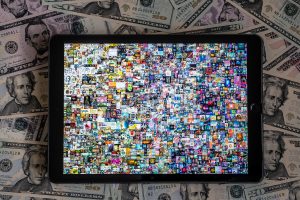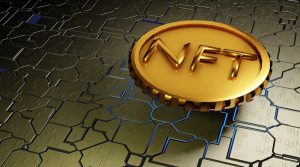In recent years, the rise of NFTs (Non-Fungible Tokens) has sparked a new conversation about digital ownership. NFTs have become increasingly popular among artists, collectors, and even gamers, as they offer a unique way to prove ownership of digital assets. But what exactly are NFTs, and how do they work? In this article, we will explore the potential for NFTs to redefine ownership in the digital realm.
What are NFTs?
To understand NFTs, we first need to understand the concept of fungibility. Fungible assets are those that can be exchanged for an identical asset of equal value. For example, cash is fungible – if you trade a $10 bill for another $10 bill, you haven’t gained or lost any value.
Non-fungible assets, on the other hand, are unique and cannot be exchanged for an identical asset of equal value. A painting by a famous artist is non-fungible – you can’t trade it for another identical painting, as each painting is unique.
NFTs are a type of digital asset that represents ownership of a unique item, such as a piece of art or a video game item. They are built on blockchain technology, which is a distributed ledger that allows for secure and transparent transactions. NFTs are unique because each one is tied to a specific asset and cannot be exchanged for another identical NFT.
The Potential of NFTs for Digital Ownership
In the digital realm, ownership has always been a murky concept. When you buy a digital file, such as a music album or an ebook, you don’t really own the file itself – you own a license to use the file. This means that the creator of the file still owns the original and can limit your use of the file.
NFTs offer a potential solution to this problem. By proving ownership of a unique digital asset, NFTs allow creators to sell their work as if it were a physical object. For example, an artist can sell an NFT that represents ownership of a digital artwork, allowing the buyer to prove ownership of the original.
The Use of NFTs in the Art World

The art world has been quick to adopt NFTs as a way to prove ownership of digital artwork. In March 2021, a digital artwork by the artist Beeple sold for $69 million at Christie’s auction house, making it the most expensive NFT ever sold.
NFTs offer several benefits for artists in the digital realm. Firstly, they allow artists to sell their work as a unique item, rather than just a copy. This can increase the value of their work and provide a new revenue stream. Secondly, NFTs provide a way to prove ownership of digital artwork, which can help to prevent piracy and ensure that artists receive proper credit for their work.
The Potential Use of NFTs in Gaming
NFTs also have potential uses in the gaming world. In some games, players can earn rare items that have a high value within the game. These items can be sold to other players for real money, but there is no way to prove ownership of the item outside of the game.
NFTs offer a potential solution to this problem. By tying ownership of a rare in-game item to an NFT, players can prove ownership of the original item outside of the game. This could lead to a more robust marketplace for in-game items and provide a new revenue stream for game developers.
While NFTs offer a potential solution to some of the problems of digital ownership, they are not without limitations. Firstly, the value of an NFT is based entirely on market demand. Just because an NFT sold for a high price in the past doesn’t necessarily mean it will continue to hold that value in the future.
Secondly, the environmental impact of NFTs has been a concern. The blockchain technology used to create and track NFTs requires a significant amount of energy. This has led to criticism of NFTs as an environmentally unfriendly technology.
Finally, there are concerns about the potential for fraud in the NFT market. As with any new technology, there is a risk of scams and fraudulent activity. Buyers need to be careful to ensure that the NFT they are purchasing is legitimate and that they are receiving the proper ownership rights.
The Future of NFTs
Despite these limitations, NFTs have the potential to change the way we think about digital ownership. They offer a new way for creators to monetize their work and for buyers to prove ownership of digital assets.
As the technology behind NFTs continues to develop, we can expect to see more innovative uses of NFTs in the future. Whether it’s in the art world, the gaming industry, or elsewhere, NFTs have the potential to redefine ownership in the digital realm.
The Pros and Cons of NFTs
Like any technology, NFTs have both pros and cons. Here are some of the main advantages and disadvantages of NFTs:
Pros
- NFTs offer a new revenue stream for creators in the digital realm, allowing them to sell their work as unique items.
- NFTs provide a way to prove ownership of digital assets, which can help to prevent piracy and ensure that creators receive proper credit for their work.
- NFTs offer a potential solution to the problem of digital ownership, allowing buyers to own digital assets in the same way they own physical assets.
- NFTs have the potential to create a more robust marketplace for rare in-game items, which can benefit both players and game developers.
Cons
- The value of an NFT is based entirely on market demand, which can be volatile and unpredictable.
- There are concerns about the environmental impact of NFTs, as they require a significant amount of energy to create and track on the blockchain.
- The potential for fraud in the NFT market is a concern, as with any new technology.
- The market for NFTs is still relatively new and unregulated, which could lead to potential risks for buyers and sellers.
NFTs and the Art World
The art world has been quick to adopt NFTs as a way to prove ownership of digital artwork. NFTs allow artists to sell their work as unique items, which can increase the value of their work and provide a new revenue stream.
NFTs also provide a way to prove ownership of digital artwork, which can help to prevent piracy and ensure that artists receive proper credit for their work. This is particularly important in the digital realm, where it can be difficult to prove ownership of digital files.
The sale of Beeple’s digital artwork for $69 million at Christie’s auction house in March 2021 brought NFTs into the mainstream art world. Since then, many artists have sold their work as NFTs, and the market for NFT art has continued to grow.
NFTs and Gaming
NFTs also have potential uses in the gaming industry. In some games, players can earn rare in-game items that have a high value within the game. These items can be sold to other players for real money, but there is no way to prove ownership of the item outside of the game.
NFTs offer a potential solution to this problem. By tying ownership of a rare in-game item to an NFT, players can prove ownership of the original item outside of the game. This could lead to a more robust marketplace for in-game items and provide a new revenue stream for game developers.
The Future of NFTs
As the technology behind NFTs continues to develop, we can expect to see more innovative uses of NFTs in the future. They have the potential to redefine ownership in the digital realm and provide new revenue streams for creators.
One area where NFTs could be particularly useful is in the music industry. NFTs could be used to represent ownership of digital music files, providing a new revenue stream for musicians and a way to prove ownership of digital music files.
However, there are also concerns about the environmental impact of NFTs and the potential for fraud in the NFT market. As the market for NFTs continues to grow and evolve, it will be important to address these concerns and develop more sustainable and secure solutions for NFTs.
Conclusion
NFTs are a new and exciting development in the world of digital ownership. They offer a potential solution to the problem of digital ownership by allowing creators to sell their work as if it were a physical object, and buyers to prove ownership of digital assets.
While there are limitations and concerns about the environmental impact and potential for fraud in the NFT market, the potential benefits are significant. As the technology behind NFTs continues to develop, we can expect to see more innovative uses of NFTs in the future.
Overall, NFTs have the potential to redefine ownership in the digital realm and provide a new revenue stream for creators. As the market for NFTs continues to grow and evolve, it will be interesting to see how they are used and how they change the way we think about digital ownership.






